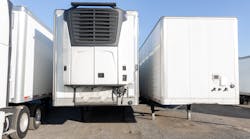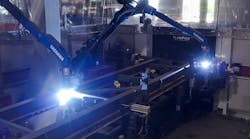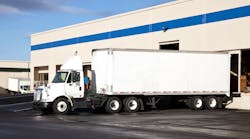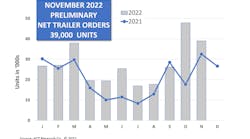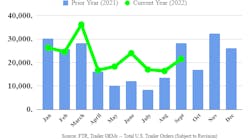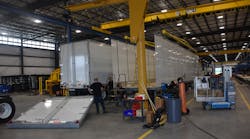THE 31 LARGEST manufacturers of truck trailers in North America collectively increased their production by slightly more than 10% last year compared to their total unit numbers produced in 2004. This is on top of a 31% gain in 2004 compared to 2003.
It is important to realize that these total figures are for trailers built in North America and are different from those produced solely in the United States. Our North American list includes a Mexican factory in fifth place and Canadian factories in seventh and eighth positions. Also, the 12th largest producer includes some international plants. Therefore, any production totals derived from this list of North American manufacturers is not directly comparable to figures derived solely from US manufacturers.
The same 10 companies heading the list of largest producers were in the top 10 list last year. However, some shuffling took place as individual manufacturers changed position.
Only one new entrant is on this year's list, and that is in the 30th place. The general rule for inclusion on the list is a manufacturer building more than 1,000 trailers annually. All of the top 25 manufacturers listed built at least 1,000 trailers in 2005. The other six manufacturers were either very close to the 1,000 mark or they indicated their companies were on track to build more than 1,000 truck trailers in 2006.
This Trailer/Body Builders survey is made by telephoning a member of the management team at each trailer manufacturing company. The survey is built on the voluntary contribution of trailer production information at each company. An estimate is made for the two companies that chose not to participate. The survey is the work of Trailer/Body Builders and should not be confused with any other survey.
-
Great Dane Limited Partnership is estimated to be the largest manufacturer of truck trailers, based on Trailer/Body Builders' in-house estimates.
-
Wabash National Corporation increased production of dry freight van trailers by 8% in 2005, building 46,870 dry vans. Refrigerated trailer production at Wabash was up 11% at 4,938 reefers. This brought Wabash National's total trailer count to 51,808 complete trailers, up 8.5% above 2004.
Domestic container production increased sharply to 2,279 units, up 54%. Wabash also built eight times as many converter dollies in 2005, building 1,424 units. This brought the Wabash National total trailer builds in 2005 to 55,511 total units, up 10.4%
The strong trailer market is continuing. William Greubel, CEO of Wabash National, says, “We expect carriers to focus on replacing and upgrading their fleets over the next few years. New technology that helps fleets to increase durability and reduce maintenance costs continues to be the focus for most trailer customers.
“Wabash National is moving forward with the next generation in trailer manufacturing. We announced major capital investment programs, including $10 million for the first phase of what is anticipated to be a $40 million multi-year program to replace four trailer assembly lines with state-of-the-art, semi-automated trailer production lines. The first line will be completed early in 2006. When complete, each line is expected to improve efficiency and production speed while providing customers with the highest quality trailers available.”
-
Utility Trailer Manufacturing chalked up an 11.5% increase in total trailer output in 2005, after scoring a 30% increase the previous year.
The total trailer count was 34,333, and just over half were refrigerated vans. The almost 17,200 reefers that Utility built was a 7% increase over the 2004 production. Utility remains the largest manufacturer of refrigerated trailers.
Utility dry freight vans were up 12% to 13,470. Platforms and curtainsiders were up 29% to 3,691 units.
The market continues very strong. Craig Bennett, senior vice-president of sales and marketing, thinks Utility will increase production another 15% in 2006. To handle the necessary capacity increase, Utility has completed the enlargement of its Marion, Virginia, reefer plant, doubling its capacity. Utility Trailer has five trailer plants, two for refrigerated vans, two for dry freight vans, and one for platforms.
-
Stoughton Trailers increased production of trailers by 14.5%, reaching above the 17,000 level. Most of these (16,400) were van trailers and 605 were platforms.
When intermodal units are included with trailers, Stoughton unit numbers were up 22.4% to 22,095 total units. The intermodal units include 2,240 container chassis, a few more than in 2004, and 2,850 domestic containers, almost three times as many as in 2004.
Don Wahlin, CEO, says that Stoughton's new Z-plate composite plate sidewall was specified for almost half of the company's van trailers. He believes that trailer production in 2006 will continue at the current high level, or possibly be down a little because of fleets' over-buying diesel tractors to avoid the coming new emissions regulations.
-
Hyundai Translead increased production of trailers 24% in 2005, but intermodal was down. The company built 11,514 van trailers, of which 590 were refrigerated. Domestic container production was 3,246, down 30%, and container chassis were 15,427, down 20%. Hyundai Translead also built 473 converter dollies.
Hyundai Translead expanded its Tijuana, Mexico, plant in 2005, and now a new line is being added in April 2006 that will increase capacity by 500 boxes (containers or trailers) per month, according to Brett Bartels, assistant manager of communications.
-
Fontaine Trailer Company reported a 15% increase in trailer production. This included 7,598 aluminum and steel platforms and 880 lowbed trailers, for a total of 8,478 trailers produced in 2005.
John Craig, VP sales and marketing, says the hurricanes caused a glitch in the market last year, but they increased demand in the lowbed division. Fuel price increases slowed aluminum trailer sales, but ordering came back strong in December and January. After tempering the rising demand for construction equipment with the negatives in the economy, he says the company is expecting a good year in 2006, but a flat one.
-
Trailmobile Canada Limited operated at maximum capacity all year, and still managed to squeeze out a 4% increase over the 2004 total. T/M Canada built 8,246 trailers in 2005, all dry vans.
Leading the growth was the Ultra-plate (composite plate) van, which has been the most successful product launch in the history of Trailmobile. Tom Wiseman, president, calls the non-plywood-lined van the “trailer of the future” because of its lower operating costs.
Wiseman believes the current market will continue during 2006, and Trailmobile will build about the same number because of capacity restraints. About 70% of its production goes to Trailmobile dealers and branches in the United States, and 30% to Canadian customers.
-
Manac enjoyed another good year of increased production, although the exchange rate problem with a weak USA dollar hurt sales into the United States. Manac built 6,600 trailers in 2005. After closing its Orangeville, Ontario, plant in 2003, Manac has concentrated its growth in the non-van trailer segment. Production is from its St Georges, Quebec, headquarters plant and Oran, Missouri, plant.
-
Strick Corporation continues producing at capacity level. Its single van plant in Monroe, Indiana, was up a slight 3% in 2004, and down 3 % in 2005. The 6,025 trailers produced in 2005 represent about the maximum that can be produced on two 10-hour shifts working four days a week. However, some plant investments are making possible a slight increase of perhaps 10% in the coming year.
Densil Williams, Strick president and CEO, sees no real growth industry-wide in 2006. The plant backlogs had been shrinking last year, but have improved somewhat in the last several months. Substantial cost increases in the last few years are a continuing problem, but 2005 was the most profitable of this decade.
Strick's sister company in Berwick, Pennsylvania, produced 7,950 Cheetah chassis. This is slightly down from the total in 2004 because the company was turning out more of the highly specialized chassis that take more time to build. Murray Zwickel, vice-president of sales and marketing at Cheetah Chassis, says 2006 could be another good year.
“We're getting lots of requests for quotes. However, the intermodal business runs on a different cycle from highway transport.”
-
Transcraft Corporation had a big increase and is forecasting another one in 2006. Transcraft built 5,635 platforms and drop-decks in 2005, a 24% increase over 2004.
David dePoncy, president, says they are projecting Transcraft will build 6,500 trailers in 2006 in the Mt Sterling, Kentucky, and Anna, Illinois, plants. The company had a strong backlog of 1,900 units in January. dePoncy says they are anticipating a big pick-up at midyear when more of the rebuilding on the hurricane-ravaged Gulf Coast picks up.
-
Vanguard National Trailer expanded production 70% in 2005, producing 4,903 dry freight van trailers. Ordering remains strong, and Rich Dessimoz, president, expects 2006 production to be up to the 8,000 level.
In addition to its sheet-and-post van, Vanguard plans to have a composite plate van as well. A new steel sheet composite sandwich produced in China will be shipped to Monon for assembly into sidewalls. The company already gets its steel fabrications from China.
-
Heil Trailer International built over 4,000 trailers in 2005, including over 900 military tank trailers and heavy haul equipment trailers. The 4,000 trailer figure is a 33% increase over 2004 and represents production from Heil's domestic and international tank trailer plants and the Kalyn Seibert heavy haul trailer plant in Texas.
Bill Harris, Heil marketing manager, says the market continues strong, and the company is predicting further growth in 2006. The pre-buying of diesel tractors is a plus, because many tank fleets maintain a one-to-one tractor-trailer ratio and will buy a new trailer to go with every tractor. The ultra-low sulfur diesel problem may also be a plus because petroleum fleets may soon buy dedicated trailers to avoid contamination of the ultra-low sulfur diesel.
-
Trail King Industries in Mitchell, South Dakota, had another record year. The company built 3,510 truck trailers, not counting the several hundred tag trailers with axles under 10,000 lb. The 3,510 represents a 10% increase over the number produced in 2004. Revenue was up 36%, but a good share of that increase can be attributed to increased material and component costs, according to Chuck Noel, vice-president of finance. Trail King concentrates on the heavy-duty lowbed market, as well as dump trailers, live floor trailers, and pneumatic bulk transports.
-
Lufkin Trailers in Lufkin, Texas, scored an 11.6% production increase in 2005, after chalking up a 42% increase in the previous year. Dry freight van production was down 10% at 2,108 vans, but both platforms and dump trailers were up significantly. Lufkin built 1,215 steel platforms and 173 steel dump trailers in 2005. Total trailer output was 3,501.
Joe Burch, fleet sales manager, says the company has a strong backlog in platforms and dumps. However, he is projecting Lufkin will build about the same number of units in 2006 because dumps and platforms can't be built as fast as dry freight vans.
-
Road Systems in Searcy, Arkansas, had an exceptional year, up 45% and turning out over 3,000 van trailers. Over two-thirds of them were new construction. The company produced 2,600 doubles trailers, of which 1,628 were new construction and 972 were refurbished. It also built 483 semitrailers, 45 to 53-ft in length, all new construction. Converter dollies, another important part of the plant production, totaled 785 refurbished units.
Lynn Reinbolt, general manager, says that orders for customers outside of CNF transportation increased substantially in 2005, and he expects this trend to continue. The company added another production line, so now one line is for doubles trailers and the other is for long semitrailers. He thinks Road Systems will have another big increase in 2006, estimating 3,127 doubles trailers and 1,825 long semis, plus 400 converter dollies.
-
Timpte Inc of David City, Nebraska, built 2,746 ag and bulk commodity trailers, an 18% increase over 2004. It reflects the good news on the farm and the change in the way some agricultural products are used. Most sales are now to the farmer-hauler, rather than to commercial haulers. More grain is going, not to the export market, but to the corn and soybean processing plants throughout the country for production of ethanol and plastic products. Timpte president Kenney Allred expects the market for ag trailers to continue and for sales to be about the same or a little bit better in 2006.
-
Kentucky Trailer in Louisville, Kentucky, had a very good year building more of its traditional drop-floor moving vans. However, it built fewer of the straight-floor dry freight vans, so the year-end totals show 203 fewer units built. This should not be interpreted as a decline. Larry Hartog, president, says revenue increased appreciably, and more than would be expected when considering the higher costs of material and components. Based on early January ordering, he expects 2006 to be a lot like 2005.
-
Reitnour Inc of Reading, Pennsylvania, increased its production of all-aluminum platforms 53% in 2005, after more than doubling its output the previous year. Going into 2005 with a backlog of 2,500 orders, the company outdid that by turning out 2,577 platforms.
The company still has a backlog of 2,500 trailers, says Bud Reitnour, and expects that to continue. Fleets are very positive about 2006.
Reitnour is ramping up production again. It started 2005 by increasing production to 55 trailers a week, and later increased it to 60 and more a week. Now in the first quarter of 2006, it is increasing to 75 trailers a week. At that rate of increase, Reitnour might have another 50% gain in total trailers for 2006.
The company started 2005 with a price increase, only the fourth price change in its 20-year history. Instead of further price increases, Reitnour is relying on surcharges to keep up with the rapidly rising cost of aluminum, hoping that the surcharges can come off when metal prices return to some normalcy.
-
East Manufacturing Corp increased production of its all-aluminum trailers by almost 30% in 2005 to 2,400 units shipped and 2,500 produced. The biggest increase was in aluminum flats and dump trailers, and the company is expecting another small increase of 5% to 10% in 2006. David Tate, president, says concern about the pre-buying ahead of the new engine emissions regulations this fall may limit the total market.
East is expanding its plant by another 50,000 sq ft, bringing the total production area for dumps, flats, and refuse trailers to 470,000 sq ft.
-
MAC Trailer Manufacturing more than met its year-ago forecast by topping the 2,000-trailer mark. The total was 2,162 trailers plus 178 truck bodies, for a total of 2,340 units carrying a serial number. This was a 48% increase. Mike Conny, president, says 2006 is starting out strong, and he expects to build 3,000 trailers this year.
To handle the increased demand, MAC has purchased a 200,000 sq ft plant 16 miles away and will move all platform production there. The company also purchased a 150,000-sq-ft warehouse adjacent to its Alliance, Ohio, plant. This means all material and component storage will be inside. The company has more than tripled in plant size in the last two years.
-
Pitts Trailers in Pittsview, Alabama, posted its third record year in a row, building 1,902 trailers in 2005. This 6% gain follows a 16% increase in units produced the previous year. Now celebrating its 30th anniversary, Pitts Trailers is expanding to meet its growing market. The company just opened a second location in Pittsview. This 15,000-sq-ft addition brings the total plant area to 170,000 sq ft. The company is adding 30 new jobs, bringing total employment to 240.
The new growth has been in the heavy-duty lowbed market, where Pitts builds 35-ton to 55-ton lowboys, both fixed and removable gooseneck. Production is about 60% in forestry trailers, such as logging and loader-delimber trailers and 40% in lowbeds.
-
Polar Tank Trailer LLC increased production 13% to 1,782 trailers. It was a very strong year, with order receipt about 1,000 over 2004, but the company was limited by capacity, says John Koll, vice-president sales and marketing.
Orders and demand are continuing strong in 2006. “We hope we can increase production by as much as 15% this year,” says Koll. “We are working on capacity improvements and the personnel to make it happen”.
-
Beall Corporation in Portland, Oregon, built 1,058 aluminum trailers in 2005, a 19.5% increase over 2004. In addition to these trailers, Beall also built 262 tank truck and dump truck bodies that are part of a truck-and-full-trailer combination. This brings Beall's total unit count in 2005 to 1,320 units, an 18% increase over 2004.
Most new orders at Beall are being booked into the first quarter of 2007. This heavy backlog is spread across all product lines. “The demand is strong in all our product lines,” says Daniel Jarboe, vice-president, marketing, “and it is very strong for petroleum tanks and aluminum bottom dumps.”
Production was ramped up 20% in 2005, so Jarboe feels safe in predicting that Beall will produce 20% more units in 2006, given the strong demand. Company orders include an escalation charge to pass on the increasing cost of aluminum and components.
-
Talbert Manufacturing Inc was back to normal production after being down for three months in 2004 in a labor dispute. The 1,002 trailers produced compares favorably with the 1,072 built in 2003 and is up 36% from the short production year in 2004. Steve Kingman, executive vice-president, thinks Talbert will almost double production in 2006 because of a six-month backlog, military contracts, and strong commercial demand in the construction industry.
-
Kidron built a few more refrigerated trailers in 2005 while ramping up production at two new plants in Montgomery, Pennsylvania, and Tulare, California, that it acquired from Grumman Olson Corp. The 990 reefers built in 2005 are all foodservice trailers ranging from 28 ft to 53 ft in length. John Sommer, executive vice-president, says that the length of choice now for foodservice trailers seems to be either 38-ft or 42-ft. The long 53-ft trailers are specified to handle backhauls when making refrigerated deliveries.
With four plants now capable of building refrigerated trailers as well as truck bodies, Sommer is predicting a 10% increase in Kidron's reefer trailer production in 2006. Kidron's headquarters plant is in Kidron, Ohio, and the fourth is in Lakeland, Florida.
-
Western Trailer Company in Boise, Idaho, increased production by 25% to 976 units in 2005. This was slightly below expectations because of the need to fill some commitments for specialized, high manhour trailers. Western has just completed a new 20,000-sq-ft building that will be used for research and development and for building specialized trailers. This additional space will free up the three production lines for higher volume orders.
Western's primary product line is flatbeds and drop-deck trailers, with bulk commodity trailers such as woodchip vans and V-bottom conveyor trailers a close second. With customer demand continuing strong, Western is planning to build 1,200 trailers in 2006, according to Craig Whitehead.
-
Benson International registered its biggest increase in dump truck bodies and stake bodies for the municipal market. Total trailers were 975, consisting of 628 platforms and 347 dump trailers. Of the 580 truck bodies, 468 were dump bodies and 112 were stake bodies.
“Benson is currently seeing a solid market and a strong order base for the coming year,” says Mike Monroe, vice-president sales and marketing. “Our new Oneida, Tennessee, manufacturing facility (opened a year ago) has far exceeded our expectations.”
Benson has another new plant in Cadiz, Kentucky, that began production the first of 2006. The Cadiz facility will be in full production in June when multiple lines will be open for equipment such as the Benson Frameless Classic and the new Benson Inner Wall Technology patent-pending design.
-
Brenner Tank LLC increased shipments again in 2005, building some 900 tank trailers, up 12% from the previous year. Robert Agnew, president, sees this trend continuing in 2006. The company is continuing to make capital investments to increase capacity. In mid-January Brenner moved into its new 9,500-sq-ft office building at the same address in Fond du Lac, Wisconsin. The company has a new president, Bruce Yakley, while Robert Agnew remains at corporate headquarters.
-
Travis Body and Trailer Inc in Houston increased production 45% in 2005 and is now looking forward to another 25% increase in its line of dump and live-bottom trailers in 2006. The company added another production line, and the current run rate of 20 per week should put Travis above the 1,000 unit mark in 2006, according to C K (Bud) Hughes, president. Travis built 843 dump trailers in 2005.
-
Clement Industries in Minden, Louisiana, increased shipments of its dump and refuse trailers by 27%, reaching 825 units. The outlook is very good, and Glen Hicks, president, is forecasting 2006 shipments of 1,210 trailers.
